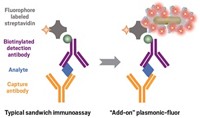Advertisement
Grab your lab coat. Let's get started
Welcome!
Welcome!
Create an account below to get 6 C&EN articles per month, receive newsletters and more - all free.
It seems this is your first time logging in online. Please enter the following information to continue.
As an ACS member you automatically get access to this site. All we need is few more details to create your reading experience.
Not you? Sign in with a different account.
Not you? Sign in with a different account.
ERROR 1
ERROR 1
ERROR 2
ERROR 2
ERROR 2
ERROR 2
ERROR 2
Password and Confirm password must match.
If you have an ACS member number, please enter it here so we can link this account to your membership. (optional)
ERROR 2
ACS values your privacy. By submitting your information, you are gaining access to C&EN and subscribing to our weekly newsletter. We use the information you provide to make your reading experience better, and we will never sell your data to third party members.
Analytical Chemistry
Glowing DNA Strands Measure Toxic Mercury In Fish
Analytical Chemistry: A new assay provides a simpler way to quantify toxic methylmercury without time-consuming separation techniques
by Puneet Kollipara
March 2, 2015

Current analytical tools for measuring levels of mercury in seafood can’t distinguish its most toxic form, methylmercury, from its ionic form. But researchers have overcome that problem with a new test that takes advantage of fluorescent DNA probes and silver ions. The tool detected methylmercury quickly, sensitively, and selectively in the laboratory and accurately measured the compound in fish samples (Anal. Chem. 2015, DOI: 10.1021/ac504538v).
More harmful than other forms of mercury, methylmercury is soluble in lipids, which enables it to breach the blood-brain barrier more readily. In aquatic ecosystems, mercury-containing substances accumulate as fish eat smaller organisms that have already ingested the element. Methylmercury can become a health concern as people eat some types of fish, especially tuna and swordfish, which are high on the food chain.
But precisely measuring methylmercury in fish is tough. Separating methylmercury from other forms of mercury requires techniques such as gas chromatography or high-performance liquid chromatography, which can be cumbersome and time-consuming. Seeking a more convenient approach, Li Deng and Ronghua Yang of Hunan University, in China, and colleagues devised a fluorescence-based method that could measure the concentration of methylmercury while ignoring ionic mercury, without any separation steps.
For fluorescent probes, the team designed DNA strands labeled with carboxyfluorescein dye that has a glow that is enhanced when bound to methylmercury. To create a molecular off-switch, the researchers add silver ions that sop up ionic mercury into Hg-Ag clusters, which then bind to the DNA strands and quench their fluorescence. The silver ions also form nanoparticles that quench the residual fluorescence of any unbound DNA strands. As a result, the researchers say, the intensity of the glow from a sample offers a way to measure methylmercury accurately, regardless of ionic mercury’s presence.
In tests of solutions containing both methylmercury and ionic mercury, the researchers showed that the fluorescence signal got consistently brighter as the concentration of methylmercury increased from 2 nM to 12 μM. Even in samples that contained 50 times as much ionic mercury than methylmercury, the researchers could accurately measure the methylmercury concentration. Ions of other metallic elements—such as copper, iron, cobalt, and cadmium—also produced little to no signal.
When the researchers tested the concentration of mercury extracted from tuna and compared their method with a traditional method, they measured 5.8 μg of methylmercury per g of tissue using fluorescence, which was similar to the 5.5-µg/g value with the traditional test. Separate fluorescence analyses on three common types of fish—snakehead, bighead carp, and grasshead carp—showed higher concentrations in the more carnivorous fish, consistent with how methylmercury accumulates as fish move up the food chain.
The findings are a good first step, says Yingfu Li, a biochemist at McMaster University, in Ontario, and they’re a novel application of fluorescent DNA probes, which are often used in medical diagnostics.
The biggest limitation right now is its selectivity for methylmercury, Li says, which might not be enough for some samples. Improvements there would allow researchers to measure methylmercury levels even if ionic mercury content is more than 50-fold higher. Additionally, Li wonders if researchers someday could develop a portable, easy-to-use colorimetric test for methylmercury similar to a home pregnancy test.





Join the conversation
Contact the reporter
Submit a Letter to the Editor for publication
Engage with us on Twitter